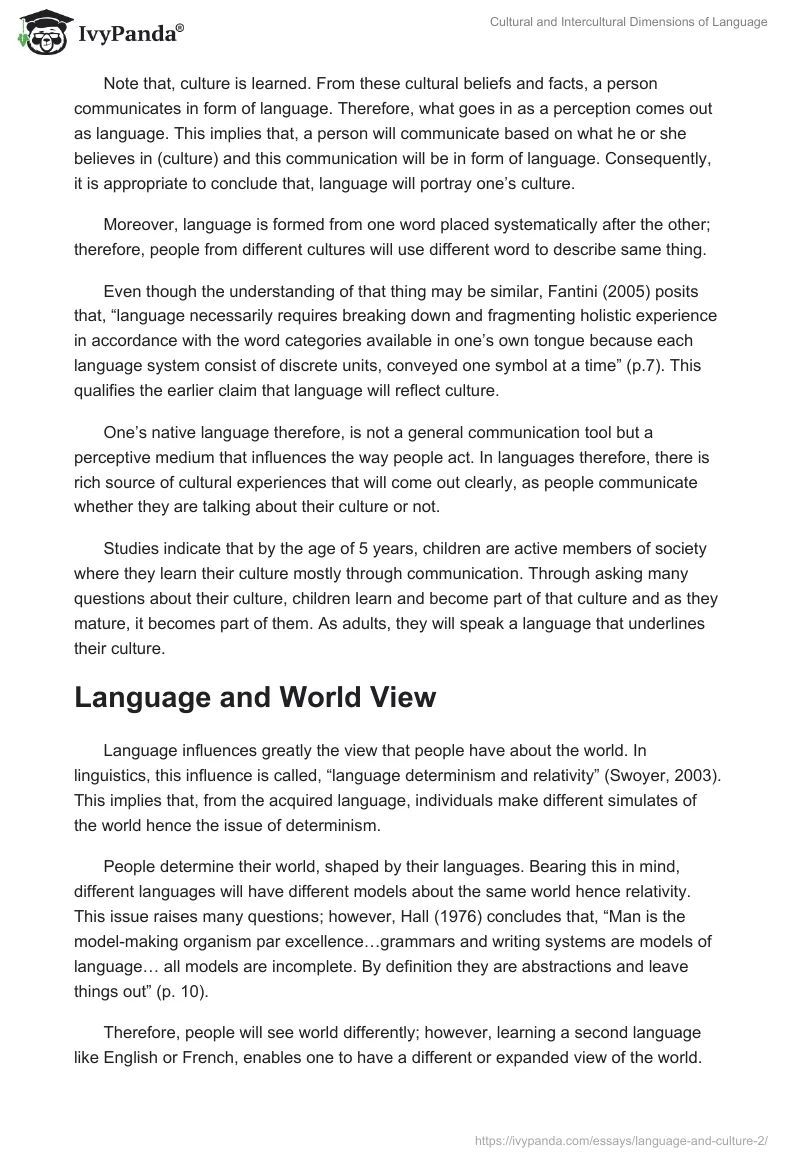Language happens to be one of the training tools and the mostly used tool in that case. People will view the world depending on their languages. “Language is the medium through which a culture expresses its world view…Like culture in general, language is learned and it serves to convey thoughts; in addition, it transmits values, beliefs, perceptions, norms, and so on” (Mulvaney, 1994).
People learn through language and whatever is learnt becomes accepted within a given culture. Just like culture, language runs deep in societies and it may be difficult to change one’s language.
Language determines how individuals deal with different issues like gender, crime, and corruption among other societal issues. “Language serves both as a mechanism for communication and as guide to social reality” (Mulvaney, 1994). This paper reviews work done by Alvino E. Fantini on Cultural and Intercultural Dimensions of Language to determine the ways in which the language reflects the culture and its worldview.
Cultural Reflection of Language
Depending on his or her language, an individual will selectively understand given aspects of a given scenario like external world. According to O’Neil (2006), culture results from behaviors that people in a given setting or environments learn. Culture is something that is learned and people learn through language.
After learning these behaviors, an individual internalizes the perceptions through a mental process whereby they become facts and beliefs. Nevertheless, to communicate these beliefs and facts from an individual to another, it requires use of language systems consisting of words and signs (Lavenda & Schultz, 2009).
Fantini (2005) refers to the process of learning as input, while the process of communicating as output (p. 6). This creates a strong correlation between culture and language making language an indicator of culture. What gets into one’s mind through the process of learning, that is, input, becomes culture.
Note that, culture is learned. From these cultural beliefs and facts, a person communicates in form of language. Therefore, what goes in as a perception comes out as language. This implies that, a person will communicate based on what he or she believes in (culture) and this communication will be in form of language. Consequently, it is appropriate to conclude that, language will portray one’s culture.
Moreover, language is formed from one word placed systematically after the other; therefore, people from different cultures will use different word to describe same thing.
Even though the understanding of that thing may be similar, Fantini (2005) posits that, “language necessarily requires breaking down and fragmenting holistic experience in accordance with the word categories available in one’s own tongue because each language system consist of discrete units, conveyed one symbol at a time” (p.7). This qualifies the earlier claim that language will reflect culture.
One’s native language therefore, is not a general communication tool but a perceptive medium that influences the way people act. In languages therefore, there is rich source of cultural experiences that will come out clearly, as people communicate whether they are talking about their culture or not.
Studies indicate that by the age of 5 years, children are active members of society where they learn their culture mostly through communication. Through asking many questions about their culture, children learn and become part of that culture and as they mature, it becomes part of them. As adults, they will speak a language that underlines their culture.
Language and World View
Language influences greatly the view that people have about the world. In linguistics, this influence is called, “language determinism and relativity” (Swoyer, 2003). This implies that, from the acquired language, individuals make different simulates of the world hence the issue of determinism.
People determine their world, shaped by their languages. Bearing this in mind, different languages will have different models about the same world hence relativity. This issue raises many questions; however, Hall (1976) concludes that, “Man is the model-making organism par excellence…grammars and writing systems are models of language… all models are incomplete. By definition they are abstractions and leave things out” (p. 10).
Therefore, people will see world differently; however, learning a second language like English or French, enables one to have a different or expanded view of the world. There are two components of language in terms of worldview; that is, appropriateness and effectiveness. Effectiveness comes when an individual views world from his or her language while appropriateness comes when someone views world from a second language. These judgments will give different views again based on the language.
Conclusion
Language is an important tool in determining one’s culture. Culture develops from perspectives that people hold towards a given scenario; this is input. The important part of reflecting this culture is the output bit of it where through language individuals communicate.
As people communicate, language determined by the underlying culture, reflects their culture. People of different cultures will interpret same things differently; this is because even though the idea may be the same (input), the arrangement of words in different languages differs greatly. Finally, language determines the view that one holds about the world through determinism and relativity.
Reference List
Fantini, A. (2005). Language: Its Cultural and Intercultural Dimensions. Web.
Hall, T. (1959). The Silent Language. Web.
Lavenda, R., & Schultz, E. (2009). Components of Language. Web.
Mulvaney, B. (1994). Gender Differences in Communication: An Intercultural Experience. Web.
O’Neil, D. (2006). What is Culture? Web.
Swoyer, C. (2003). The Linguistic Relativity Hypothesis. Web.


